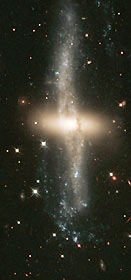
Enregistrez gratuitement cette image
en 800 pixels pour usage maquette
(click droit, Enregistrer l'image sous...)
|
|
Réf : S02600
Thème :
Galaxies (118 images)
Titre : Ring Around a Galaxy
Description : (La description de cette image n'existe qu'en anglais)
Space Telescope Science Institute astronomers are giving the public chances to decide where to aim NASA's Hubble Space Telescope. Guided by 8,000 Internet voters, Hubble has already been used to take a close-up, multi-color picture of the most popular object from a list of candidates, the extraordinary 'polar-ring' galaxy NGC 4650A. Located about 130 million light-years away, NGC 4650A is one of only 100 known polar-ring galaxies. Their unusual disk-ring structure is not yet understood fully. One possibility is that polar rings are the remnants of colossal collisions between two galaxies sometime in the distant past, probably at least 1 billion years ago. What is left of one galaxy has become the rotating inner disk of old red stars in the center. Meanwhile, another smaller galaxy which ventured too close was probably severely damaged or destroyed. The bright bluish clumps, which are especially prominent in the outer parts of the ring, are regions containing luminous young stars, examples of stellar rebirth from the remnants of an ancient galactic disaster. The polar ring appears to be highly distorted. No regular spiral pattern stands out in the main part of the ring, and the presence of young stars below the main ring on one side and above on the other shows that the ring is warped and does not lie in one plane. Determining the typical ages of the stars in the polar ring is an initial goal of our Polar Ring Science Team that can provide a clue to the evolution of this unusual galaxy. The HST exposures were acquired by the Hubble Heritage Team, consisting of Keith Noll, Howard Bond, Carol Christian, Jayanne English, Lisa Frattare, Forrest Hamilton, Anne Kinney and Zolt Levay, and guest collaborators Jay Gallagher (University of Wisconsin-Madison), Lynn Matthews (National Radio Astronomy Observatory-Charlottesville), and Linda Sparke (University of Wisconsin-Madison).
|
|

